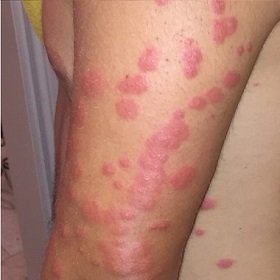Everything You Need To Know About Bed Bug Bites
Preface
Homeowners frequently mention waking up with bites or red bumps, when speaking to a bed bug control company, since it is one of the symbols of a bed bug infestation; people have been taught to associate any type of morning bites and unusual red bumps with bed bugs. However, many homeowners are very uneducated about the peculiarities of bed bug bites, what makes them different from other red bumps, and why waking up with red bumps does not justify an immediate bed bug treatment. The following article teaches you the basics of bites, and other branching matters.
Mouth & Saliva
Let’s start from the beginning: the mouth parts (and more importantly: the saliva) of a bed bug. A bed bug bite is actually the bed bug puncturing your skin using its needle-like mouthparts. When this happens the saliva (which contains a large number of proteins, including anticoagulants) of the bed bug causes an immune system response which leads to the various reactions you see at the place of bites.
Will You Always See A Bump?
The red bumps some individuals see from bed bug bites is the reaction of the body to the bed bug saliva. If your body does not react to the bed bug bite, then you will not see the effects of the bite on your body! In the latter case, a bed bug infestation may grow before you even notice it, since there is no sign of bites (even though the bed bugs are feeding).

People that display a reaction to bed bug bites are known as reactive individuals. Reactive individuals can make up anywhere between 30% to 90% of the population, and the elderly seem to be less reactive than the young (data findings taken from Advances in the Biology and Management of Modern Bed Bugs). People who do not have any reaction to bed bug bites are non-reactive individuals.
In general, the dermatological reactions one may experience can range from small bumps to wider, red swelling at places of bites, and even bullae breakouts. And other few common characteristics of being bitten by bed bugs:
- itchiness at place of bites
- a punctum in the center of any skin lesions; this is the place where the bed bug punctured the skin
- sleep loss/waking in the middle of the night
Do Bed Bugs Transmit Disease?
Now, a question most people might be wondering:
Do bed bugs transmit diseases when they bite?
Current study of the matter shows that bed bugs do not transmit disease in natural situations and infestations. Meaning: there have been studies that show bed bugs being able to transmit pathogens, however these number very few and are contrary to observations that take place in the field. The matter is highly debated but consistent results of virtually no transmission in real life situations overcomes the contested and debated conclusions of a few studies. What you should know right now are 3 main points:
- Bed bugs do not transmit HIV; there is insufficient evidence to suggest this
- Bed bugs do not transmit Hepatitis B; there is practically a negligible chance of transmission in a house infestation
- Bed bugs may transmit Trypanosoma cruzi, which causes the Chagas disease.
The above findings are based on research and writings from the well-known source: Advances in the Biology and Management of Modern Bed Bugs published by Wiley.
Misidentification Of Bed Bug Bites
Homeowners often misidentify a reaction to carpet beetle larvae to be bed bug bites (many might immediately hire a treatment and not even know that they did not have a bed bug infestation to begin with). Any bodily reaction that produces red bumps cannot be easily dismissed or ascertained as a bed bug bite reaction. The easiest way to avoid this misidentification is to have a proffessional bed bug inspection; if further evidence in your home indicates a bed bug infestation, then the problem is bed bugs.
If no bed bugs, then it will probably be another pest, (such as carpet beetles) which will be brought to your attention within the inspection.
If neither occurs, then it is a good idea to see medical practitioners such as a dermatologist, because the problem may not always be a pest.

Poorly vacuumed spaces and carpeted areas can lead to a carpet beetle problem. Carpet beetle larvae hairs cause an allergic reaction which people mistake as bed bug bites. In fact, homeowners mistake carpet beetles themselves to be bed bugs!. Among many differences between the two: carpet beetle infestations are far easier to deal with.
There have been many instances where homeowners thought and may have even been certain that they had bed bugs – but really, their body was reacting to carpet beetle larvae hairs. This is why simply having bites, or red bumps, is not the consequences of having bed bugs, and homeowners should not jump to conclusions.


